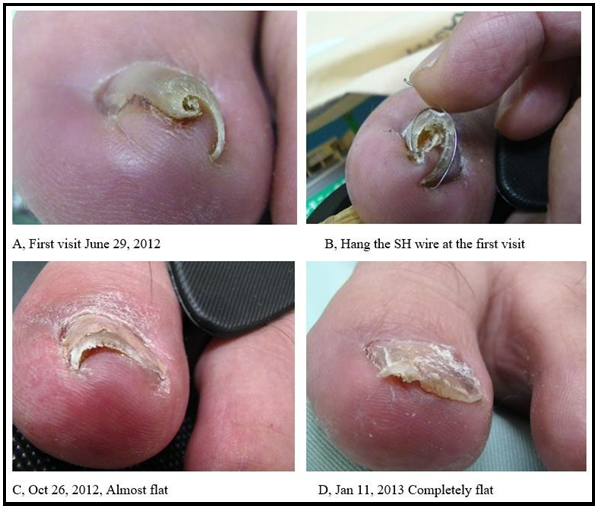Hideo Sogawa
*Corresponding Author: Hideo Sogawa, 1091 Shimotakano, Toyonaka - cho, Mitoyo - shi, Kagawa 769 - 1508, Japan.
1. Summary
There are various treatments for ingrown toenail, but when the nail is short and the granulation is large, it is often difficult to raise the nail without pain and eliminate the ingrown state.
2. Sogawa nail correction method
The Sogawa nail correction method is a new nail correction method originally developed by Hideo Sogawa in 2011. The most distinctive feature of this method is to take a method of gradually lifting the nail from the periphery of the painful area without touching the painful area. Lift at the first visit, and a few days later, lift the nail closer to the invagination. In some cases, lift the central claw further. In this way, the orthotic device is hung step by step in two or three times. As a result, painless treatment has been realized.
3. Case view
Case1, 74-year-old female, first visit November 17, 2021
Medical history: Nothing to note.
Chief complaint: Intense pain and granulation of the left toe Progress: One month ago, due to ingrown toenail, another doctor underwent partial resection of the nail. Since then, pain and granulation have increased. At our hospital, hang the wire at the first visit and hang the second wire 3 days after the first visit. Healed 56 days after the first visit. (Figure 1).
Figure 1: Case 1, a 74-year-old female
Case 2: 50-year-old man, first visit June 29, 2012
Pre-existing illness: Nothing to be noted.
Chief complaint: Strongly wound ingrown toenail on the left hallux, with strong swelling and pain.
Progress: Received partial nail ablation at another doctor six months ago. After that, the nail was rolled up extremely. Two SH wires were hung in stages and healed smoothly without pain (Figure 2).
Figure 2: Case 2, 50-year-old man
4. Past achievements
In the last 10 years and 9 months, we treated 7900 ingrown toenail by this method, and the cure rate was 99.5 % (7863/7900). Thirty-seven patients who did not heal were treated with the phenol method and the course was good.
5. Consideration
Traditional nail devices either hook the wire on the nail edge or puncture the nail to secure the wire. However, in the Sogawa method, the wire is fixed to the nail with an adhesive. By doing so, the wire can be hung diagonally. That made this step-by-step treatment possible. Diagonal hanging is not possible with the above-mentioned method of making holes in hooks and nails. That is, the adhesive method is an indispensable technique for stepwise treatment. There are various techniques for adhering to the wire and the nail, such as preparing the surface of the nail, devising the grip of the wire, and processing.
This technique can be learned in our NET course. You can learn more about the technology by email.
Writer: Hideo Sogawa
Address: 1091 Shimotakano, Toyonaka-cho, Mitoyo-shi, Kagawa 769-1508 Sogawa Clinic Hideo Sogawa\
Work and position: Director of Sogawa Clinic
Email: h-sogawa@mx4.et.tiki.ne.jp
References:





